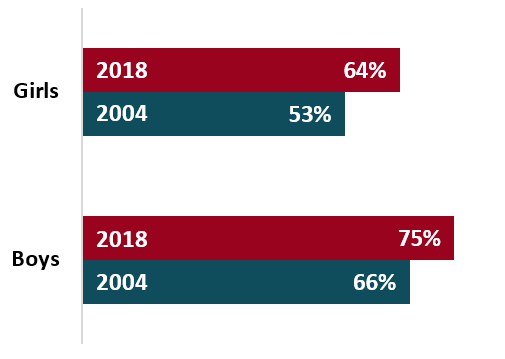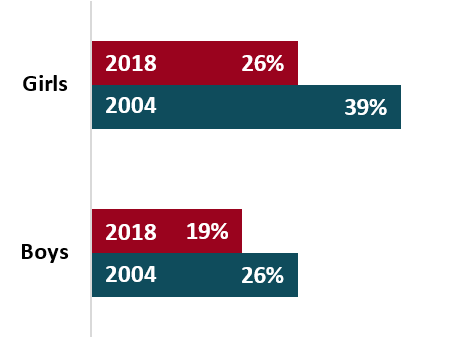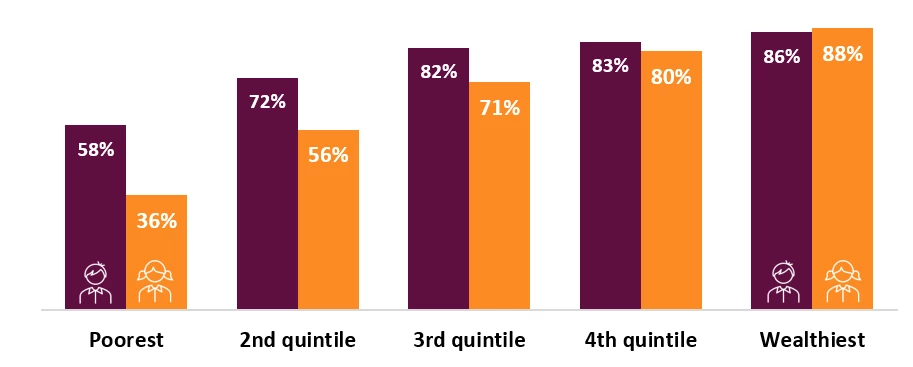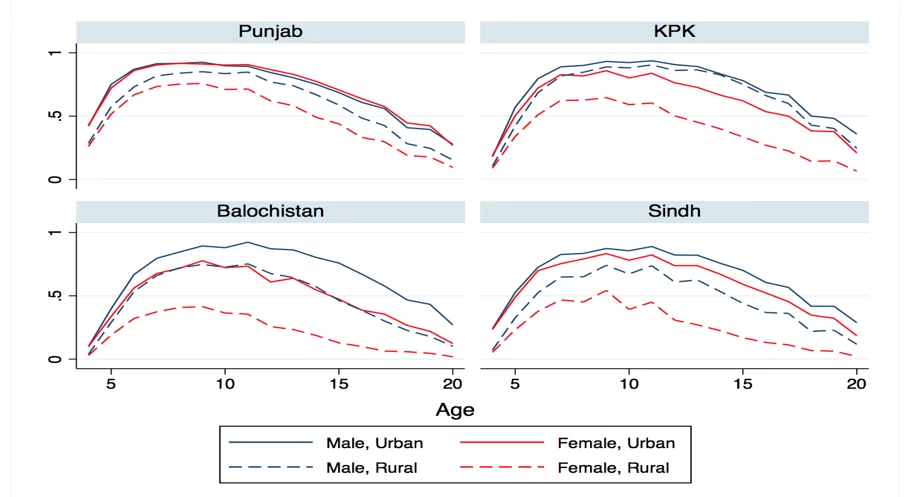 Girls’ school in Islamabad, Pakistan. Photo credit: Insiya Syed, © World Bank.
Girls’ school in Islamabad, Pakistan. Photo credit: Insiya Syed, © World Bank.
Girls’ education is smart economics, and Pakistan has committed to guaranteeing the right of both girls and boys to access quality education (SDG 4).
In fact, Pakistan has dramatically expanded enrollment for girls and boys in the last 14 years. Net enrollment for both has increased by roughly 10 percentage points (Figure 1). With a school-aged population of around 50 million children, there have been substantial gains in the number of children enrolled in school. However, the country faces a number of challenges in ensuring a quality education for all children: 75 percent of 10-year-olds in Pakistan cannot read a simple text, and that rate may have increased to 79 percent due to COVID-19 and the 2022 floods.
Despite progress, girls in Pakistan face more challenges in accessing quality education and their education outcomes lag boys. Bringing more girls and boys to school will require using data to target interventions to specific challenges. At the current pace (which already incorporates strong assumptions on progress), it will take Pakistan at least 50 years to enroll all girls and 31 years to enroll all boys. Below, we present potential solutions to challenges facing girls access to education.
Figure 1. Net enrollment rates by sex (%)

Challenge 1: 12 million girls out of school
About 2 million more girls than boys are out of school in Pakistan–or about 12 million girls in total—and account for most of the out-of-school population in Pakistan. Estimates of the number of out-of-school children in Pakistan range from 20.3 to 22.1 million children.
Solutions. One solution includes using available data and targeting specific programs to specific types of out-of-school children. For example, bringing back young kids who may have dropped out of primary school is a targeted intervention for young kids who were in school, but not for teenage children who may have left the system years ago. A literacy, numeracy, and life skill programs would be a more targeted approach for this group.
Another solution is increasing school supply: Punjab has done it successfully in primary education with public-private partnerships (PPPs). Expanding PPPs to other levels of education and enhancing regulations can deliver big returns. Expanding and better managing public schools in rural areas is another solution, like the SELECT project in the Sindh Province.
Challenge 2: Girls are more likely to have never been to school
In 2018, 26 percent of girls and 19 percent of boys had never been to school, a 7-percentage point difference (Figure 2). Pakistan has made progress compared to 2004, when the difference was 13 percentage points. The effort, however, has left girls in the same position as before relative to boys. Figure 2 shows that in 2018, the number of girls who have never attended school was the same as the number of boys who never attended school in 2004 (14 years earlier).
Solutions. Expanding conditional cash transfers to incentivize parents to send children to school, with a premium on girls, could be effective to enhance early enrollment and reduce gender gaps. Enrollment drives focused on first grades and pre-K enrollment can also be effective.
Figure 2. Children who have never attended school by sex (%)

Challenge 3: Girls in poor families are less likely to attend school
Poverty is a major challenge for girls’ education. Girls in poor families are 22 percentage points less likely to attend school than boys (Figure 3). This gender gap gets narrower with better-off families, ending with no gap for families in the wealthiest quintile, where enrollment is around 87 percent, for both sexes.
Figure 3. School enrollment by sex and household wealth (%)

Moreover, girls in poor families are 52 percentage points less likely to attend school than girls in well-off households (Figure 3). This highlights what families express as the biggest constraint to sending girls to primary school: the cost of education. Girls in rural areas, who are more likely to be in poor households, are also less likely to be enrolled than any other group, including girls in urban areas and boys in both rural and urban areas (Figure 4). Girls in rural areas are the most disadvantaged group.
Solutions. Pakistan has recently expanded the conditional cash transfer program to all districts in the country and has had girls’ stipend programs with positive outcomes. Expanding and consolidating this financial support to families—differentiating by gender and rural areas—could help in closing these gaps. These financial conditionalities will only work if there are enough schools available, which is not the case in many rural areas of Pakistan. For example, there are nearly 130,000 primary schools in rural Pakistan, but only 33,000 middle schools, leaving many middle school-aged students in rural areas without education options after primary school.
Figure 4. In all provinces, girls of all ages in rural areas are less likely to be in school than boys

Challenge 4: Security of girls and women at school
Girls face harassment in school and on the way to school. They face challenges to their security in public spaces, transportation, and near schools. Girls express anguish at all types of harassment in these spaces, the Center for Gender and Policy Studies reports. Given this, parents in Pakistan either delay girls’ education or prevent them from attending school altogether. The second most important reason parents give for not sending girls to school is the distance to schools, which is a factor that exacerbates parents’ security concerns: the more distant the school, the more risk for girls.
Solutions. Improving transport services for girls and female teachers, as has been done in KP Province, and making school safe for students (for example, building boundary walls in schools).
What’s next?
Pakistan has shown that increased enrollment for girls is possible even in a context of high population growth. To accelerate progress, programs could be based on cost-effectiveness, potential for scale, and new research. For example, countries can advance girls’ education through un-targeted programs as effectively as targeted programs, as outlined in research by Evans & Yuan. This is true in some domains, but targeted interventions would work best for specific constraints faced by girls. The above potential solutions reflect both.
Solutions, however, require adequate and well-executed funding. Pakistan spends 2.5 percent of its GDP on education, far from the 4 percent international average. Reducing gaps and ensuring that all children, in particular girls, have access to quality education would require at least 4.5 percent of GDP, the World Bank estimates.



Join the Conversation